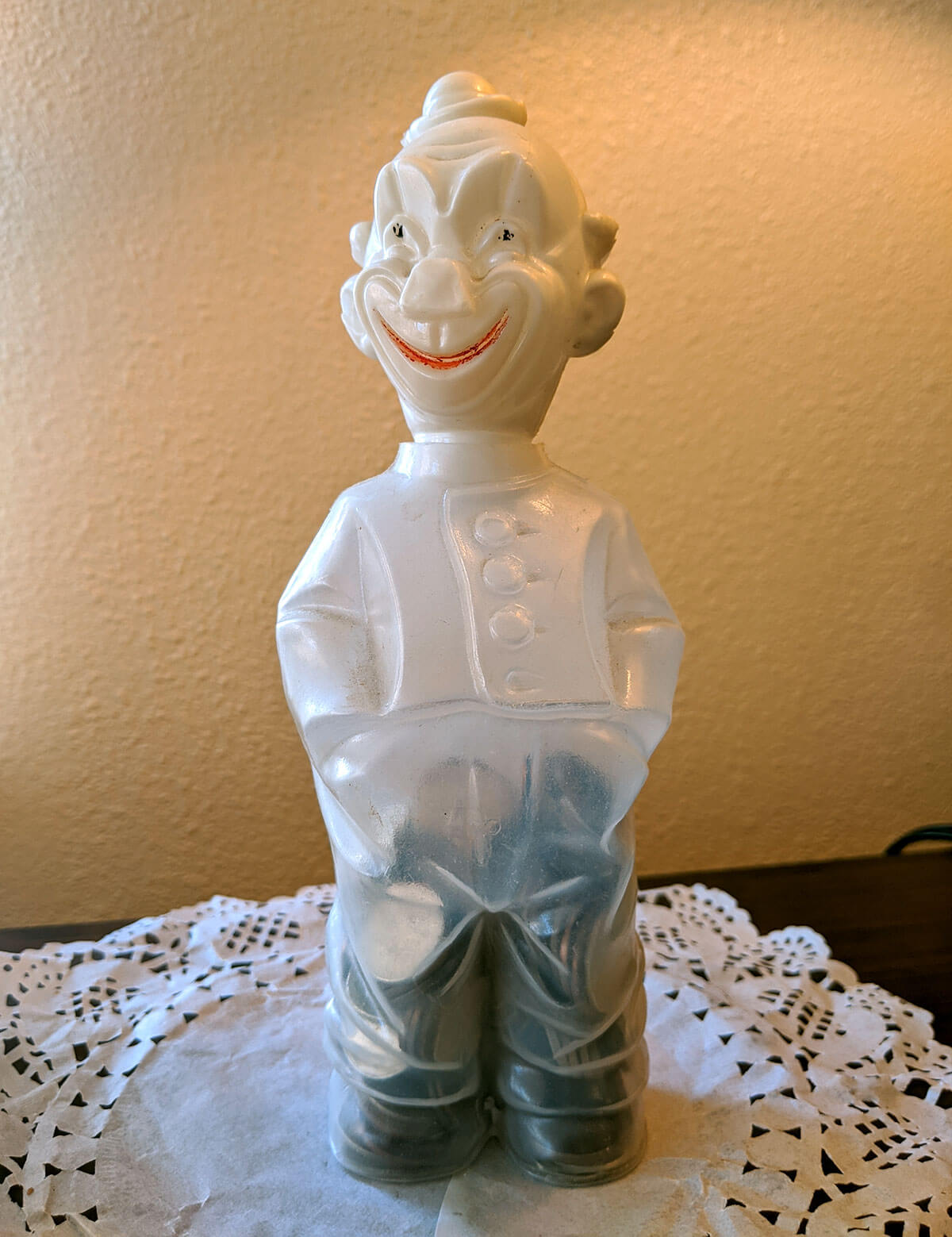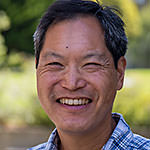
On my grandmother’s dresser stood a little white-headed clown on a cotton crocheted doily. Whenever I entered her bedroom I would stare at him, because through his clear, plastic body I could see pennies, dimes, and quarters. My Paw Paw’s limited English and schooling kept her from working outside the home much, so she had no savings and few possessions. In fact, one of the few things I inherited from her was this clown, which she had kept for decades.
I recently figured out why she saved this clown and its spare change for so long. Coins minted before 1964 had a 90 percent silver content, and can be valuable for their mint condition and purity.

The Lady with a Negative Footprint
As far as I could tell, Susie Shue, my Longdu-speaking grandmother, had a negative carbon footprint. As an immigrant from Zhongshan, China, where thriftiness was a finely-honed skill after centuries of famine, and as a mother raising four children through the Depression, she mastered a minimalist lifestyle.
I learned well from my Paw Paw, who was my childhood caretaker and local conservationist who preserved every resource possible. You name it — she saved bags, rubber bands, paper clips, all manners of small things in our kitchen drawers for future reuse. I never had a lunchbox, because I would refold my smiley face paper bag and tuck it in my back pocket daily. Long before we had curbside recycling, she helped me collect and keep aluminum cans in our basement. I have no idea how we figured out where to bring them for redemption, but we got our cash back.
She practiced the “top things to reduce one’s personal carbon footprint” early in the 1970s before we even knew about the upcoming climate apocalypse. She didn’t drive, but walked ever so slowly, holding my hand to take me shopping at Thom’s, the local organic grocery store on Clement Street. Of course, she never flew on an airplane, save her one return trip to China. Paw Paw didn’t buy new clothes, but she regularly wore the same sweaters and fuzzy slippers that we got her for Christmas. They kept her warm well enough, so she never turned on the heat. After doing her laundry in cold water, she hung her clothes out to dry. And of course, she would turn off the television whenever I fell asleep watching it on the sofa, which was another one of our daily rituals.
Susie’s carbon footprint was negative, if that is possible, because her backyard garden offset her own carbon emissions. She would mulch with coffee grounds and eggshells, and grow scallions and leeks for my favorite steamed chicken dish. We’d always have an avocado pit, suspended with toothpicks, sitting on our window sills. Even when we failed to keep our lawn green, the weeds and sourgrass sequestered what little carbon my grandmother emitted.
Chinese grandmas, like mine, actually do have lighter carbon footprints than the average American. Those in San Francisco Chinatown, for instance, use half as much energy as other city residents. We can learn from their ways, both in their lifestyle and in their care.
Recycling Street Grandmas
Because I was so attached to my own Paw Paw, I have a special affinity for other grandmothers, especially the ones I see scrounging for recyclables in my neighborhood in East Oakland. These elderly women in colorful polyesters can be seen early mornings geared in their work uniforms: white cotton gloves, hand-sewn sleeve covers, and metal hooks curved to fish cans from garbage bins. I doubt that they can earn much, especially with the increased competition over cans and bottles from unhoused neighbors, but the women are out on the streets regularly and dutifully.
I imagine that they see recyclables as found money dropped on the streets. Who doesn’t like finding forgotten cash discovered in a pocket, or picking up a quarter spotted on the ground? The discovery of hidden treasures must bring them such secret pleasure and glee.
I am enamored by these grandmas because, besides being pirates in hunt for lost booty, they have good hearts behind their cheap, critical exteriors. They may not necessarily recycle for their own income, yet every little bit of cash they can bring in does help the family budget in our working-class city. Our seniors don’t retire but continue to do their bit — and share their two bits — for the household. Whenever I see a grandmother unwrap a piece of candy for their heavily-sweatered grandchild in Chinatown, I figure she had to scrounge a lot for that special treat. This thrifting and scrimping, like my Paw Paw had done, was all done with thought and concern for the next generations.
Family Sacrifices as a Transpacific Lived Tradition
My new book, co-written with Seanan Fong and Helen Kim, "Family Sacrifices: The Worldviews and Ethics of Chinese Americans", shares countless stories of just that — the offerings of love that Chinese share with each other. Inheriting the traditions of Confucianism and Chinese Popular Religion, Chinese American grandparents and parents pass down to the next generations the values of sacrifice, family loyalty, and corporate responsibility as a lived tradition. They may not necessarily espouse explicit beliefs in the existence of ancestral spirits or the ultimate truth of Confucian Analects, but they do hold tightly to rituals of family that offer meaning and belonging.
Cary Yu, a communications consultant who works on environmental justice campaigns, learned these values from her own small family, especially through food. Even though she grew up on an isolated farm in Oregon, she always ate breakfast together with her father and her uncle’s family, who lived with them. When her grandmother passed away, the family traveled back to Taiwan for an elaborate burial ceremony. Each family member actually took chopsticks and held up food for their deceased grandmother in the casket to provide for her in the afterlife. Connected to relatives an ocean away, Cary explained, “This ceremony was an embodied understanding of what it means to be family.” She extends this Chinese notion of family to her work as an environmental activist: “I hold the round and squareness of Western individualism and Confucian responsibility. I’m constantly thinking of my place in society and the role of communal health — rather than only individual health — and the collective consciousness. Putting those together as one.”
Even though she laments that she’s “crappy” at filial piety and rarely communicates with her father, she continues to worry about his health, as well as the welfare and immigration status of her cousins. And like my Paw Paw and the recycling grandmas, she plans to assume generational responsibility for her family to come. Still single, she concludes, “I really don’t know what family looks like in the future. Regardless if I don’t have children, I’m going to put my wealth in securing my friend’s children. That’s where I’m putting my energies.”
Generational Social Responsibility: A Biblical Tradition
A lifestyle of simplicity and delayed gratification is countercultural to today’s hyper-individualistic and media-crazed market economy. The Bible, however, highlights that God’s people are heroes of faith when they lead lives of sacrifice and service in future hope of Jesus’ coming, God’s honor, and generational blessing.
Nehemiah, for example, could have lived comfortably in his position of power and prestige. Instead, he heard about and saw the ruins of Jerusalem. In repentance for Israel’s corporate sin, he sought to restore its walls and environment. When the people suffered from famine, climate distress, and taxing debts, he ordered the nobles and officials to stop their usurious practices. Further, he himself set an example of simplicity, refusing to eat the food allowance of the governor.
Nehemiah’s concern for justice, the built landscape, and the common good ultimately upheld the holiness of God and established a model for the next generation. The book of Nehemiah purposefully lists and names the households of those who returned and rebuilt Jerusalem, just so that the future generations could remember their ancestors’ devotion to God and their households.
Creation Care as a Generational Responsibility
I’m paralyzed and terrified by the global climate crisis confronting us. As I rue over the prospects of my children for a safe and clean environment, I am led to repentance for the rapacious behavior of my generation, and for our chilling disregard for God’s creation. And in my mind, I wonder “How shall we make restitution to repair the damage we have done?”
My Paw Paw, other Chinese American families, and our heroes of the faith provide clear examples of how we need to live to restore creation. We need to tread lightly on this earth, like my grandmother, in order to lessen our carbon footprint. We must live simply and responsibly, as the Asian American immigrant generation has done, in concern for future generations as acts of family devotion. And we must act with burning urgency, using our power like Nehemiah to repair our damaged environments, especially on behalf of the marginalized and next generation.
When I pass away, I’ll leave to my son the white-headed clown that I received from my Paw Paw. Although it’s small and may not look like much, it holds her legacy, that of other-centered boundaries and boundless interconnectedness. And along with this family heirloom, I pray that I can bequeath to him a world that is much more sustainable than what we have now. May we steward God’s creation so that, like the coins my grandmother left me, it will be kept pure and in mint condition.

Russell Jeung is the author of “At Home in Exile: Finding Jesus Among My Ancestors and Refugee Neighbors” (Zondervan 2016), in which he recounts his family’s six generations in California, how they reflect the racialized history of Asians in the U.S., and how he has come to terms with his own Asian American Christian identity. He founded Stop AAPI Hate with Chinese for Affirmative Action and the Asian Pacific Policy and Planning Council to counter surging Covid-19 racism.